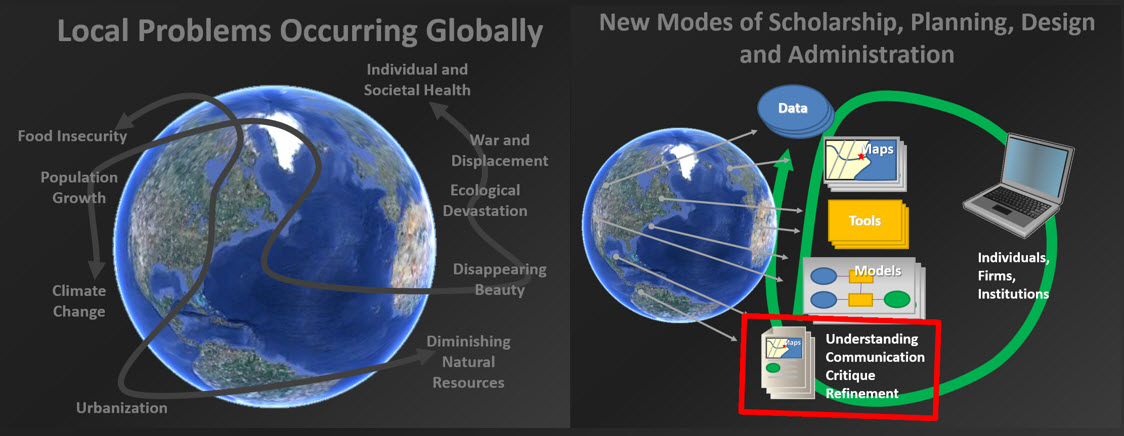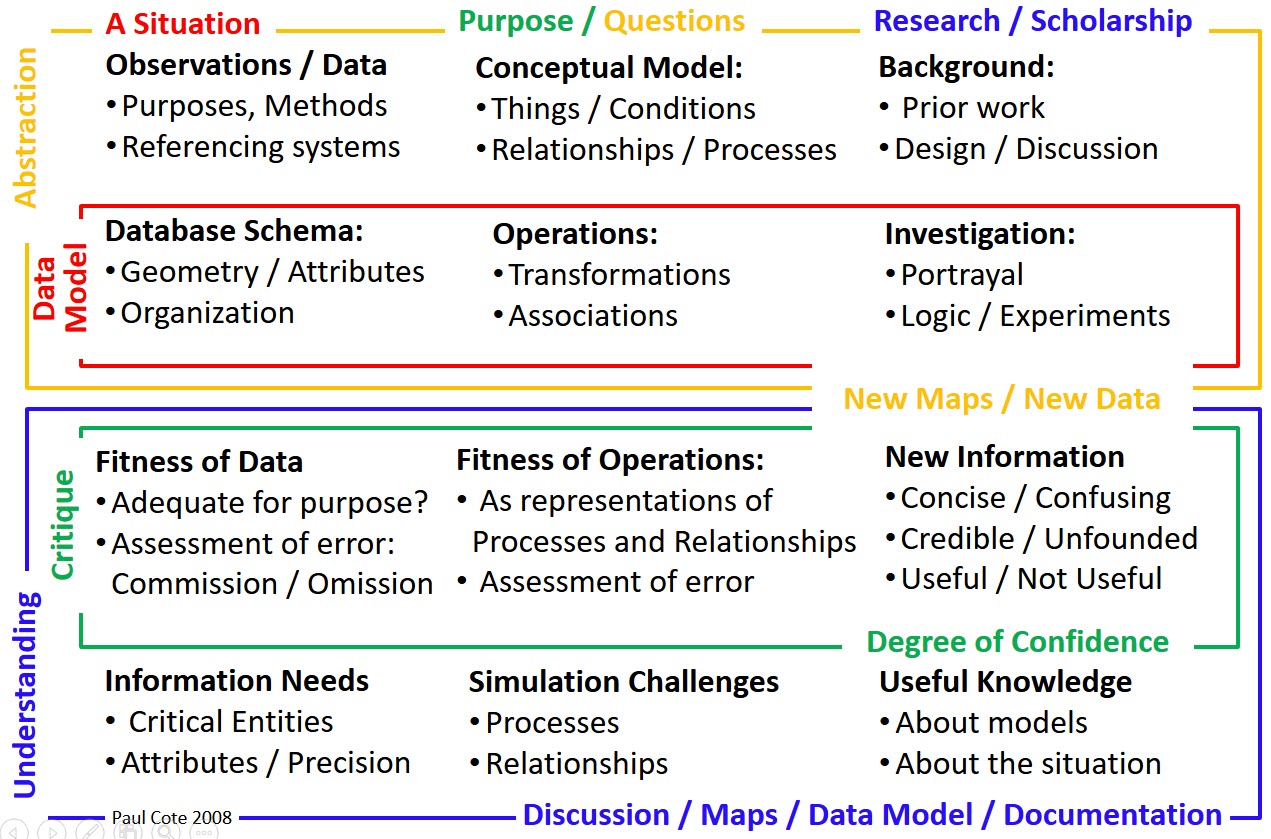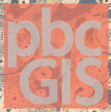Are Geographic Information Systems Useful?
Spatial Models in Decision Making Context
The practice of Geography encompasses a set of techniques for organizing and sharing observations and references such that observations made by independent sources might be used together to understand real and hypothetical situations. Geographic models may be useful for developing and communicating an understanding of how things and conditions affect eachother. This is the sort of information that designers and policy analysts often have to make. Geographical models can be useful for conducting hypothetical (What-If?) experiments that explore plausible ways that critical aspects of situations might be affected by change: either intentional or natural. These essential aspects of the craft of geography have not changed for thousands of years.
In the present day, our ability to collect and organize observations (data) and to combine and transform data to generate new information, including maps and models, make Geographic Information Systems (GIS) an essential tool for designers and policy analysts. Each of these professions has a responsibility to assemble information to develop and communicate credible, plausible, understanding and recommendations related to change, whether the change may be deliberate or inevitable.

The previous paragraphs paint an optimistic picture of how data and GIS can be useful in decision-making situations. Yet, it is most important to understand that it is much easier and very common to use data, software, maps, and models in ways that are NOT useful. Therefore, the use of GIS in decision-making situations requires more than simple software skills, but also a mode of communicating that reflects a clear understanding of the aspects of a situation that may be represented with data and procedures. With a well defined question in hand, the fitness of data and procedures for that particular modeling purpose may be evaluated. If an analysis does not reflect this level of understanding, then the client or the general public may rightfully question whether the designer or analyst adequately understands what he or she is talking about.
Demystifying GIS
People who do not understand GIS and geographic data well, often think of data and models in magical terms. Either data and models are magically all-knowing and perfect, or they are propaganda tyhat is not to be trusted. An educated analyst, on the other hand, understands that data and tools can be evaluated in terms of their fitness with regard to a well-described question. The key to understanding whether GIS is usefulor not pivots on our ability to formulate a question that can be addressed using data and tools.
A Decision-Making Situation
In this course, we are interested in describing Decision-Making Situations Each project will describe a real or hypothetical situation involving things and conditions that have some defined spatial relationship. Within this situation, there is a question about a change that may take place -- either as a deliberate intervention or natural process or some combination of the above. The goal of each exercise is to describe how specific data-sets may be used to describe the things and conditions, and GIS procedures can be used to illustrate or simulate the spatial relationships.
The reason for insisting on this specific type decision-making scenariop about the sorts GIS applications we will make, is that there are plenty of ways to use GIS, for example, making art, or mysterious info-graphics, which in the end can't be evaluated in terms of a practical purpose. This course is all about learning how to describe situations that can be modeled with GIS and data, and evaluating the results in terms of ouir pre-defined goals.
A Recipe for Designing and Evaluating a GIS Model
The diagram below provides an outline of the key elements of an analytical application of GIS. The area witin the red box represents the Data Model which is the piece of the analysis that is carried out using software to explore and transfrom data -- hopefully to understand critical aspects of the relationships of things and conditions possibly interacting in a place. For many, this is computer-based work is where the Magic of GIS happens. After one learns a little bit about what data and GIS are, it becomes clear that the most important aspects of a practical GIS application are in understanding data, developing answerable questions, and interpreting the results.
Flip through the slides below to get an idea of how terms are organized in the framework for designing and evaluating GIS models in decision-making situations.

The Question and the Conceptual Model
No situation can be modeled or understood completely. Yet, it may be possible to discuss specific things, conditions and relationships that may make a difference. Often, a diagram is a very useful tool for describing a concern in terms of the way that particular things and conditions are related in space. To begin making a map or constructing a more complicated data model without a conceptual description of the decision-making situation is literally pointless. Each of the exercises in this course will involve describing a hypothetical situation and a concern in terms of a conceptual model. Lots of ideas about how to describe a conceptual model and a hypthetical situation are provided on the page: Describing your Conceptual Model.
A simple conceptual model can be outlined as shown below:
- Describe a set of things or a geographical condition
- Describe another set of things or another geograhical condition
- Describe a relationship between the 1. and 2. that includes a description of the physical mechanism through which the first thing or condition affects the second.
Accessibility Example:
- Libraries
- Homes with Children
- Children that live within a one kilometer walking distance of a library are more likely to use the library
Exposure Example
- Smokestacks emitting airborne particles
- Homes of vulnerable residents
- Homes that are down-wind form smokestacks are at greater risk for exposure
Landscape Conncectivity Example
- Forest-dwwelling species
- Tree canopy
- Gaps in tree canopy diminish the viability of forest-dwelling species.
Understanding and Properly Attributing Data
It is very common to come across maps and policy or design presentations that use data as a magical representation of things and conditions in the real world. This is often the first sign that the analyst, unfortunately does not understand what he or she is dealing with. It is extremely irresponsible to create or use analytical work that implies such assumptions. In reality, data are collections of observations gathered through purpose-specific methodology at some time in the past. There are about half a dozen critical aspects of data that ought to be part of the introductory discussion before one gets down to the nitty gritty of using GIS. These are discussed in more detail on the page: Discussing Geographical Data in Decision-Making Context.
Data-Driven Investigations
It is rare that an aanalyst has control over the scope and quality of data that is available. Therefore, the framing of a question and conceptual model is conducted in tandem with exploring and evaluating data. It may be that the first step involves the conceptualization of a system in ideal terms, but it is not useful to spend too much time on this until you have a good idea of what sorts of data are available for use in your data model. After understanding and evaluating available data, the specification of the decision-making situation and conceptual model or geographical area of interest may be shifted to focus on things, conditions and relationships that may be representet, even if imperfectly, with data that you can actually get, understand and describe. Advice for discovering data is provided on the page: Discovering Geographic Data.
Investigating Prior Work
It may not be necessary to do a deep literature review as part of each weekly exercise in this course, but for term projects or other actual projects, it is wise to investigate the ways that others have approached the sorts of modeling and decision-making situations that you are concerned with. These investigations will hopefully give you a boost over predictable simplistic approaches toward more interesting or effective approaches than you might arrive at by starting from scratch. Consulting prior work may provide insights into the availability of data Your creidibility as an analyst is improved if you cite one or two prior studies that have some bearing on the approach that you decide to take.
The Data Model
Once a question has been defined in terms of things, conditions and relationships, and once data has been acquired which represents the things and conditions, the analyst is ready to begin working with GIS. The concepts outlined within the red box on our diagram describes the critical tasks of creating models in GIS. These procedures wil be described in much more detail as the course continues. In general, the GIS is used to to explore associations among the things and conditions represented by the data. The result may be maps or logical what-if experiments.
Abstraction and New Information
So far we've discussed the top part of the diagram. It is useful to think of these activities and ideas as being related to the purpose-specific digestion of situations into abstract data and procedures. The result of all of this abstraction activity is New Data and New Maps, which hopefully shed some light on how the situation may actually be affected by changes, or at least would shed some light on our understanding of the challenges of creating a useful model with the data and procedures that we have at our disposal.
Understanding
The new data and maps that we create must be discussed. If it is left to the client, member of the public, or your instructor to figure out what the new map or data means, then the analyst has not done his or her job! The only reason for creating a map oe any other data model is to improve understanding. This is often the most difficult part for students, but we will not shy away form this even in the very first assignment! In the bottom half of our diagram lays out a recipe for describing your practical understanding of the data model and it's results.
Evaluating the Presentation
The value of a GIS analysis in any context rests in effective, credible communication. Is the presentation concise or confising have sources and methods been properly regonized and attributed in the text and in more formal citations? Has the analyst avoided common pitfals of cartographic representation? Or does he or she appear to be confused, or implying a reliance on the magical all knowing power of data by leaving these issues unexplained? In this course and the real world, your clients, the public and your instructors are going to be asking these questions. So you should try to stay one jump ahead bu addressing these concerns yourself. Sometimes at this phase of the project, the analyst discovers that concepts and procedures that can not be explained concisely can be adjusted in the model or maps to make the analysis more effectively understood.
Critique of Data
One of the trickiest habits that data analysists must break is promoting a belief that data represent a perfect view of things and conditionswith regard to the question at hand. This is obviously foolish, but people do it all the time. Hopefully, everyone that has completed this course (even the first exercise, will learn the simple way to explore and discuss useful hallmarks and errors of data with special focus on the strenggths and weaknesses of our data with repect to representing the things and conditions stipulated in our conceptual model. Many of these issues and also advice for formatting necessary citations for data sourcs are discussed in more depth in the page entitled Evaluating Data in Decision-Making Context.
Critique of Operations
As this course moves forward, we will go much deeper into the way that we can use the associative and transforming procedures in GIS to model spatial relationships. These procedures include the simple transformation of selected data into graphical symbols (cartography) and also simulation of spatial effects that might be aggivated or mitigated by changes in the arrangement of things and conditions. An easy way to approach this essential sspect of the critique of projects amounts to thinking through the way that GIS procedures perform as simulations of real-world spatial mechanisms that have been defined in the conceptual description of the analysis. Stay tuned in later weeks for a deeper discussion of this aspect of GIS.
Summary Understanding
At the bottom of the blue box in our diagram we find the aspects of the study that boil down the take-aways from the analytical activity. These are the pieces that get back to the question of whether anything useful has been learned.
Don't Play at Data Analysis Theatre!
One common gaffe commited by students in introductory GIS courses is succumbing to the tempting shortcut of pretending that the magical data and GIS have revealed the answer to the question at hand. It is surprising to see how common this tactic is, even after students have been warned not to do it. In the real world, pretending to be an analyst and pretending to use GIS to develop pretend answers to questions is called fraud. We do not encourage this approach at all in this course!
Degree of Confidence
This takes us to the three blocks of concepts at the bottom of the diagram. Since we have stipulated that propjects are evaluated in terms of their utility in practical situations, we have to end by assigning some degree of confidence in our findings. It goes without saying that data and models are imperfect. A serious approach to using data in practical situations has to involve some discussion of the likely magnitude and direction of the errors that are likely to result form our use of imperfect data and procedures. In the end, we may find that the project is not worthwhile in terms of predicting impacts of change or for making recommendations. This is often the case when we are working on one-week projects.
Useful Knowledge
If one has time to experiment with data models and iteratively adjust the question and the real-world or hypothetical scope of the question, a person can become skilled at designing questions that may be productively be explored using data-sets and simulation procedures that are accessible. It is often the case, especially when working on weekly assignments, that one must conclude that the data and procedures that one has on hand have shortcomings that impact the data's fitness as a representation of the real world or hypothetical things and conditions that one set out to understand. Rather than seeing this turn of events as a failure, it is not hard to describe a couple of important recommendations for finding data and simulation tools that are better suited to the problem at hand.
Thoughtful Discussion of Information Needs
Regardless of the degree of confidence that you may have developed regarding the problem-solving powwer of a GIS application, it is always useful to try to boil down the experience to recommsnd potential improvements or alternate avenues for analysts who may attempt to model similar situations in the future. For example, any analysis can be attempted at different scales and data having different geometric or categorical granularity. After working through a data analysis at one levelof detail, a thouightful analyst might discuss the potential to explore the same sort of situation at another geographic scope with data of greater or lesser precision.


